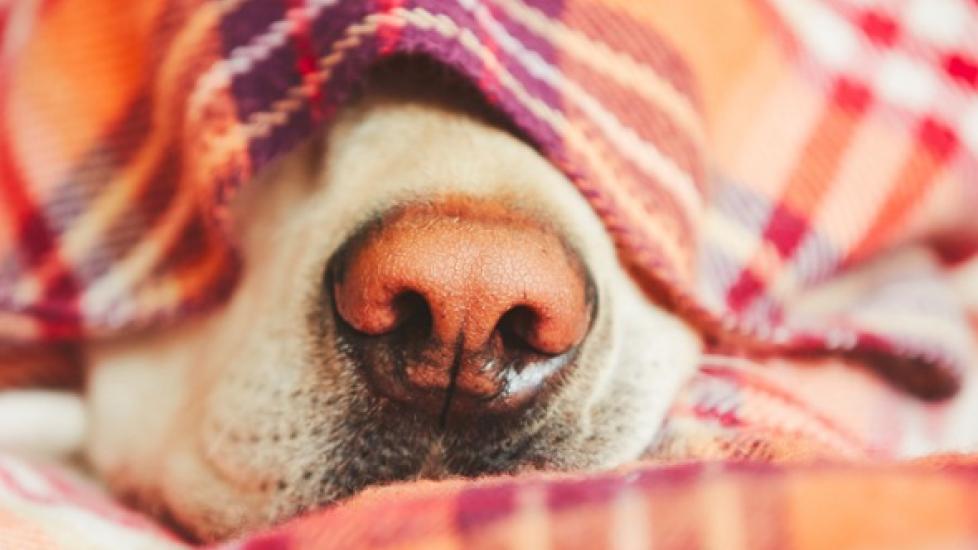What is Dog Snow Nose and What Can You Do About it?
Reviewed for accuracy on March 19, 2019, by Dr. Katie Grzyb, DVM
If your dog’s nose turns from its usual dark color to pink or brown, specifically during the winter, your dog may have what is commonly referred to as “dog snow nose” or “winter nose.”
The condition, which is called “hypopigmentation,” typically causes a dog’s nose to lighten in color—normally to a pink or light brown. The color the nose turns will depend on the original color of your dog’s nose.
If your dog normally has a black nose, it turns pink or a darker brown. If your dog has a brown nose, it may turn a lighter shade of brown.
What Causes Dog Snow Nose?
“We’re not sure what causes it, but since it occurs most often in winter or cold weather climates, we think it might have something to do with the temperature or possibly certain enzymes,” explains Dr. Sandra Koch, a board-certified veterinary dermatologist and associate professor of dermatology at the College of Veterinary Medicine at the University of Minnesota in St. Paul, Minnesota.
Dog snow nose is most often seen in winter, but it can also occur in summer or even in tropical areas, says Dr. Koch. “We have very limited information on it; there has been little research done, and most of the information we have is anecdotal,” says Dr. Koch.
Should Pet Parents Be Concerned?
One of the reasons there has been little research done into the condition is that dog snow nose itself is not harmful to your dog and should cause no concern, says Dr. Christine Cain, a board-certified veterinary dermatologist and assistant professor of dermatology and allergy at the University of Pennsylvania School of Veterinary Medicine in Philadelphia.
“The condition is completely cosmetic and seems to be incidental and will wax and wane; the nose will typically return to its natural color eventually,” says Dr. Cain. However, in some instances, she says, the nose will remain a lighter color.
It should be noted, says Dr. Cain, that dog snow nose does not change the nose’s texture or moisture—it only affects the color, typically in the central part of the nose. “That part should still be that cobblestone texture,” says Dr. Cain. “If it is getting smoother and smoother or is raw or there are sores, you should see your veterinarian.”
Could It Be Something Other Than Snow Nose?
If your dog is continuously rubbing his nose, or if the nose has sores, complete changes in pigmentation, changes in texture or moisture, or is crusting, bleeding or itching, then you should discuss these symptoms with your veterinarian. These types of issues can be an indication of something more serious, such as cancer, lupus infection or an immune disease known as vitiligo.
There may be other benign reasons that your dog’s nose may change color. Although Dr. Cain says it isn’t common, some dogs lose the pigment on their nose from eating or drinking from plastic dog bowls.
If you don’t see any other changes in your dog’s nose and suspect this to be a problem, you can switch to a dog bowl like the Bergan stainless steel pet bowl or the Van Ness stainless steel pet bowl.
What Should You Do to Prevent Snow Nose?
Since veterinary science has yet to determine the cause of dog snow nose, there is really nothing that can be done to prevent it, says Dr. Cain.
“Snow nose is really nothing to worry about; it is not linked to skin cancer or any other conditions; it is benign and just cosmetic,” says Dr. Cain.
Which Dogs Are Affected?
It most commonly affects Siberian Huskies, Golden Retrievers, Labrador Retrievers and Bernese Mountain Dogs, although it can affect any breed, says Dr. Koch, and Dr. Cain says she has even seen it affect some smaller breed dogs.
Some pups are born with brown dog noses, which is normal and not the condition known as snow nose. Dog snow nose typically affects the central part of the nose, or the pigment of the flat part of the nose called the nasal planum, says Dr. Cain.
By: Kerri Fivecoat-Campbell
Featured Image: iStock.com/Chalabala
